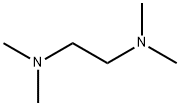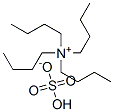A7857212
N,N,N′,N′-Tetramethylethylenediamine , 96% , 110-18-9
Synonym(s):
TMEDA;TEMED;Putrescine;1,4-Diaminobutane;1,4-Butanediamine
CAS NO.:110-18-9
Empirical Formula: C6H16N2
Molecular Weight: 116.2
MDL number: MFCD00008335
EINECS: 203-744-6
Update time: 2022-07-08
PRODUCT Properties
| Melting point: | −55 °C(lit.) |
| Boiling point: | 120-122 °C(lit.) |
| Density | 0.775 g/mL at 20 °C(lit.) |
| vapor density | 4 (vs air) |
| vapor pressure | 21 hPa (20 °C) |
| refractive index | n |
| Flash point: | 50 °F |
| storage temp. | Store below +30°C. |
| solubility | H2O: 10 mg/mL at 20 °C, clear, colorless |
| form | Liquid |
| pka | 10.40, 8.26(at 25℃) |
| Specific Gravity | 0.777 (20/4℃) |
| color | Clear colorless to slightly yellow |
| Odor | Amine like |
| PH | 8.0-8.5 (0.1g/l, H2O, 20℃) |
| explosive limit | 1-9%(V) |
| Water Solubility | miscible |
| Sensitive | Hygroscopic |
| Merck | 14,9134 |
| BRN | 1732991 |
| Stability: | Stable. Highly flammable. Incompatible with strong oxidizing agents, acids, acid chlorides, acid anhydrides, copper, mercury. |
| InChIKey | DMQSHEKGGUOYJS-UHFFFAOYSA-N |
| LogP | -0.13 at 20.2℃ |
| CAS DataBase Reference | 110-18-9(CAS DataBase Reference) |
| NIST Chemistry Reference | 1,2-Ethanediamine, N,N,N',N'-tetramethyl-(110-18-9) |
| EPA Substance Registry System | Tetramethylethylenediamine (110-18-9) |
Description and Uses
N,N,N',N'-Tetramethylethylenediamine is used as polymerization accelerator in gel electrophoresis, solvent and oxidizing reagent. It is also used for the separation of proteins or nucleic acids. Further, it is employed as a ligand for metal ions like zinc and copper. It is actively involved in the formation of anionic organometallic complex.
Safety
| Symbol(GHS) |    GHS02,GHS05,GHS06 |
| Signal word | Danger |
| Hazard statements | H225-H301+H331-H314 |
| Precautionary statements | P210-P233-P280-P303+P361+P353-P304+P340+P310-P305+P351+P338 |
| Hazard Codes | F,C,Xi |
| Risk Statements | 11-20/22-34-20/21/22 |
| Safety Statements | 16-26-36/37/39-45 |
| RIDADR | UN 2372 3/PG 2 |
| WGK Germany | 1 |
| RTECS | KV7175000 |
| F | 3-8-10-34 |
| Autoignition Temperature | 145 °C |
| Hazard Note | Irritant |
| TSCA | Yes |
| HazardClass | 3 |
| PackingGroup | II |
| HS Code | 29212900 |
| Hazardous Substances Data | 110-18-9(Hazardous Substances Data) |




